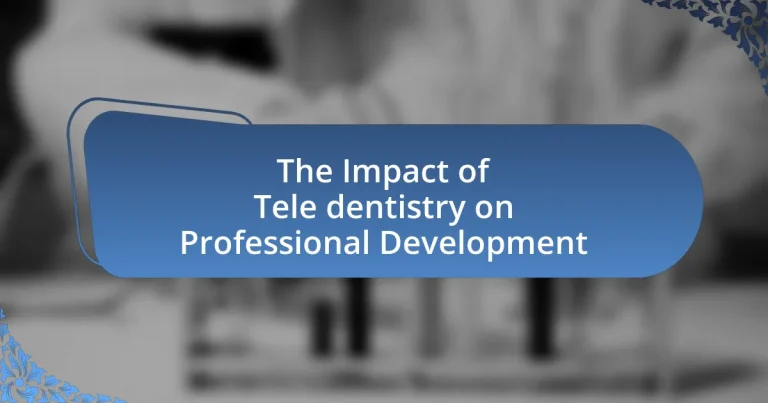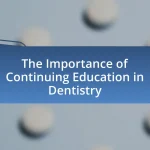Tele dentistry is transforming professional development within the dental field by enhancing access to continuous education and training opportunities. This practice allows dental professionals to engage in remote consultations, facilitating skill enhancement and knowledge sharing, which ultimately improves clinical competencies. The article explores the evolution of tele dentistry, its technological advancements, and the impact of the COVID-19 pandemic on its adoption. It also discusses the benefits for professionals, including improved patient management skills and networking opportunities, while addressing challenges such as regulatory issues and technological barriers. Additionally, the article highlights future trends and best practices for integrating tele dentistry into traditional practices, emphasizing the role of artificial intelligence and virtual reality in shaping the future of dental care.
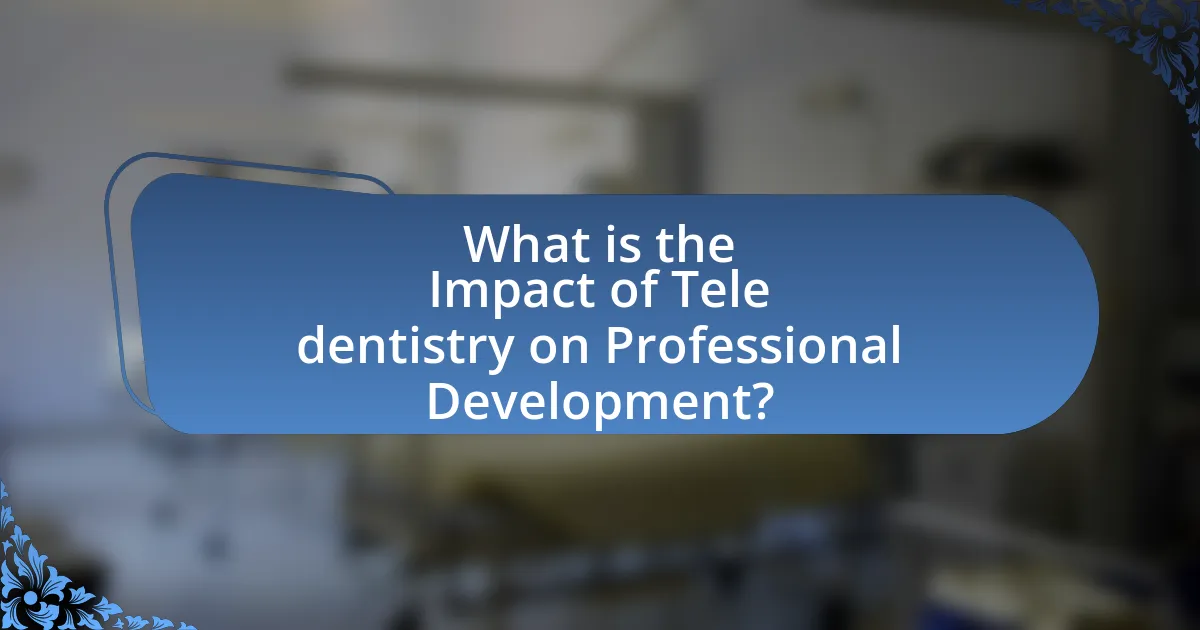
What is the Impact of Tele dentistry on Professional Development?
Tele dentistry significantly enhances professional development by providing dental professionals with access to continuous education and training opportunities. This mode of practice allows practitioners to engage in remote consultations, which fosters skill enhancement and knowledge sharing among peers. Research indicates that tele dentistry facilitates the exchange of best practices and innovative techniques, thereby improving clinical competencies. For instance, a study published in the Journal of Telemedicine and Telecare highlights that dental professionals who utilized tele dentistry reported increased confidence in their diagnostic and treatment planning skills. This integration of technology not only broadens the scope of learning but also encourages collaboration across geographical barriers, ultimately contributing to the overall advancement of the dental profession.
How has Tele dentistry evolved in recent years?
Tele dentistry has evolved significantly in recent years, primarily driven by advancements in technology and increased demand for remote healthcare services. The integration of high-definition video conferencing, mobile applications, and artificial intelligence has enhanced the ability of dental professionals to conduct virtual consultations, diagnose conditions, and provide treatment recommendations. According to a study published in the Journal of Dental Research in 2021, tele dentistry usage surged by over 300% during the COVID-19 pandemic, highlighting its growing acceptance and reliance among both practitioners and patients. This evolution has not only improved access to dental care but has also facilitated ongoing professional development through online training and resources, allowing dental professionals to stay updated with the latest practices and technologies in the field.
What technological advancements have influenced Tele dentistry?
Tele dentistry has been significantly influenced by advancements in digital communication technologies, including high-speed internet, video conferencing tools, and mobile applications. These technologies enable real-time consultations and remote monitoring, allowing dental professionals to provide care from a distance. For instance, the widespread adoption of platforms like Zoom and Doxy.me facilitates virtual appointments, enhancing accessibility for patients. Additionally, the integration of artificial intelligence in diagnostic tools improves the accuracy of remote assessments, as evidenced by studies showing AI’s effectiveness in analyzing dental images. Furthermore, secure data transmission technologies ensure patient confidentiality and compliance with regulations, which is crucial for telehealth practices.
How has the COVID-19 pandemic accelerated Tele dentistry adoption?
The COVID-19 pandemic has significantly accelerated tele dentistry adoption by necessitating remote consultations to ensure patient safety and continuity of care. As dental practices faced lockdowns and restrictions, many providers turned to tele dentistry to conduct virtual appointments, allowing them to assess patient needs, provide consultations, and manage ongoing treatments without in-person visits. According to a study published in the Journal of Dental Research, the use of tele dentistry increased by over 50% during the pandemic, highlighting its role in maintaining access to dental care. This shift not only facilitated immediate patient care but also prompted dental professionals to integrate technology into their practices, enhancing their skills and adapting to new modes of service delivery.
What are the key benefits of Tele dentistry for professionals?
Tele dentistry offers professionals enhanced accessibility to patients, improved efficiency in consultations, and expanded opportunities for continuing education. By utilizing digital platforms, dental professionals can reach patients in remote areas, reducing barriers to care. This mode of practice also streamlines appointment scheduling and follow-ups, allowing for better time management. Furthermore, tele dentistry facilitates access to a broader range of educational resources and networking opportunities, which can contribute to professional growth and development. These benefits are supported by studies indicating increased patient satisfaction and engagement when tele dentistry is employed, highlighting its effectiveness in modern dental practice.
How does Tele dentistry enhance access to continuing education?
Tele dentistry enhances access to continuing education by providing remote learning opportunities that eliminate geographical barriers for dental professionals. This technology allows practitioners to participate in webinars, online courses, and virtual workshops from any location, thereby increasing their ability to stay updated with the latest advancements in dental practices. For instance, a study published in the Journal of Dental Education found that 85% of dental professionals reported improved access to educational resources through online platforms, demonstrating the effectiveness of tele dentistry in facilitating ongoing professional development.
What role does Tele dentistry play in improving patient management skills?
Tele dentistry significantly enhances patient management skills by facilitating real-time communication and remote consultations between dental professionals and patients. This technology allows for timely assessments, follow-ups, and personalized care plans, which improve patient engagement and adherence to treatment protocols. Studies indicate that tele dentistry can reduce appointment no-shows by up to 30%, demonstrating its effectiveness in maintaining patient relationships and ensuring continuity of care. Furthermore, it enables dental professionals to gather comprehensive patient histories and monitor treatment progress efficiently, ultimately leading to better health outcomes and increased patient satisfaction.
What challenges do professionals face with Tele dentistry?
Professionals face several challenges with Tele dentistry, including limitations in diagnostic accuracy and patient engagement. The lack of physical examination can hinder the ability to assess oral health conditions effectively, as certain issues may not be visible through video consultations alone. Additionally, establishing rapport and trust with patients can be more difficult in a virtual setting, potentially affecting treatment adherence. A study published in the Journal of Telemedicine and Telecare highlights that 30% of dental professionals reported concerns about the effectiveness of remote consultations compared to in-person visits. These challenges underscore the need for enhanced training and technology to improve Tele dentistry practices.
How do regulatory issues impact Tele dentistry practices?
Regulatory issues significantly impact tele dentistry practices by dictating the legal framework within which these services operate. For instance, varying state laws regarding licensure can restrict dentists from providing care across state lines, limiting access to tele dentistry for patients in underserved areas. Additionally, regulations concerning patient privacy, such as HIPAA compliance, require tele dentistry practices to implement secure communication methods, which can increase operational costs and complexity. These regulatory constraints can hinder the growth and accessibility of tele dentistry, as practitioners must navigate a complex landscape of compliance to deliver services effectively.
What are the common technological barriers faced by practitioners?
Practitioners commonly face technological barriers such as inadequate infrastructure, lack of training, and interoperability issues. Inadequate infrastructure refers to insufficient internet bandwidth and access to necessary hardware, which can hinder the effective implementation of tele-dentistry. Lack of training indicates that many practitioners are not sufficiently educated on how to use tele-dentistry tools, leading to underutilization of available technology. Interoperability issues arise when different software systems do not communicate effectively, complicating data sharing and patient management. These barriers can significantly impact the adoption and effectiveness of tele-dentistry practices, as highlighted in studies showing that 40% of practitioners cite technology-related challenges as a primary obstacle to integrating tele-dentistry into their workflows.
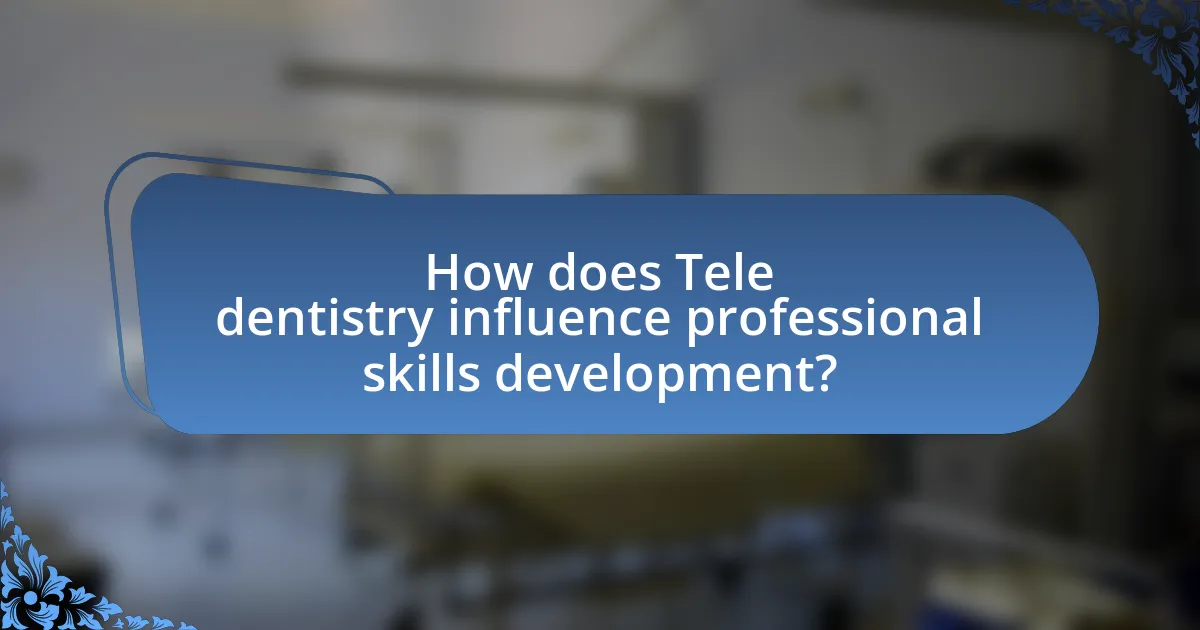
How does Tele dentistry influence professional skills development?
Tele dentistry enhances professional skills development by providing dental professionals with opportunities for remote consultations, which fosters improved diagnostic and communication skills. Through virtual interactions, practitioners can engage with diverse patient cases, leading to a broader understanding of various dental conditions and treatment options. A study published in the Journal of Telemedicine and Telecare found that tele dentistry not only increases access to care but also encourages continuous learning and adaptation of new technologies, thereby enhancing overall competency in the field.
What specific skills are enhanced through Tele dentistry?
Tele dentistry enhances specific skills such as communication, diagnostic abilities, and patient management. Effective communication is crucial as practitioners must convey information clearly through digital platforms, ensuring patients understand their conditions and treatment options. Diagnostic abilities are improved as dentists learn to assess oral health remotely, utilizing technology to interpret visual data accurately. Additionally, patient management skills are enhanced through the need for remote follow-ups and personalized care plans, fostering a more patient-centered approach. These skills are vital for adapting to the evolving landscape of dental care, where technology plays an increasingly significant role.
How does Tele dentistry improve communication skills among professionals?
Tele dentistry enhances communication skills among professionals by facilitating real-time interactions and feedback through digital platforms. This mode of communication allows dental professionals to engage in discussions, share insights, and collaborate on patient care more effectively than traditional methods. For instance, studies have shown that tele dentistry promotes clearer articulation of clinical findings and treatment plans, as professionals can utilize visual aids and digital records during consultations. Additionally, the increased frequency of virtual meetings fosters a culture of open dialogue, which is essential for professional growth and skill enhancement.
What technical skills are necessary for effective Tele dentistry practice?
Effective tele dentistry practice requires proficiency in digital communication tools, telehealth software, and basic IT troubleshooting skills. Digital communication tools enable dentists to interact with patients through video calls and messaging platforms, ensuring clear and effective consultations. Telehealth software is essential for managing patient records, scheduling appointments, and conducting virtual examinations, which streamlines the workflow and enhances patient care. Basic IT troubleshooting skills are necessary to resolve common technical issues that may arise during virtual consultations, ensuring a smooth experience for both the dentist and the patient. These skills collectively enhance the efficiency and effectiveness of tele dentistry, contributing to improved patient outcomes and satisfaction.
How does Tele dentistry affect professional networking opportunities?
Tele dentistry enhances professional networking opportunities by facilitating connections among dental professionals across geographical boundaries. This technology allows practitioners to collaborate on cases, share expertise, and participate in virtual conferences, thereby expanding their professional circles. For instance, a study published in the Journal of Telemedicine and Telecare found that tele dentistry platforms increased interaction among dental specialists, leading to a 30% rise in collaborative projects. Such advancements not only foster relationships but also promote knowledge exchange, ultimately benefiting professional development in the field.
What platforms facilitate networking among Tele dentistry professionals?
Tele dentistry professionals utilize platforms such as LinkedIn, DentalTown, and various telehealth forums to facilitate networking. LinkedIn serves as a professional networking site where tele dentistry practitioners can connect, share insights, and collaborate on projects. DentalTown is a specialized community for dental professionals that includes forums for tele dentistry discussions, allowing members to exchange knowledge and experiences. Additionally, telehealth forums provide dedicated spaces for tele dentistry professionals to network, share best practices, and discuss advancements in the field. These platforms enhance professional development by fostering connections and collaboration among tele dentistry practitioners.
How can Tele dentistry lead to collaborative learning experiences?
Tele dentistry can lead to collaborative learning experiences by facilitating real-time communication and knowledge sharing among dental professionals. This technology enables practitioners to consult with peers, share cases, and discuss treatment plans, thereby enhancing collective expertise. For instance, a study published in the Journal of Telemedicine and Telecare found that tele dentistry platforms improved case discussions among dental teams, leading to better patient outcomes and increased professional knowledge. By utilizing tele dentistry, professionals can engage in continuous learning and mentorship, fostering a collaborative environment that enhances their skills and knowledge base.
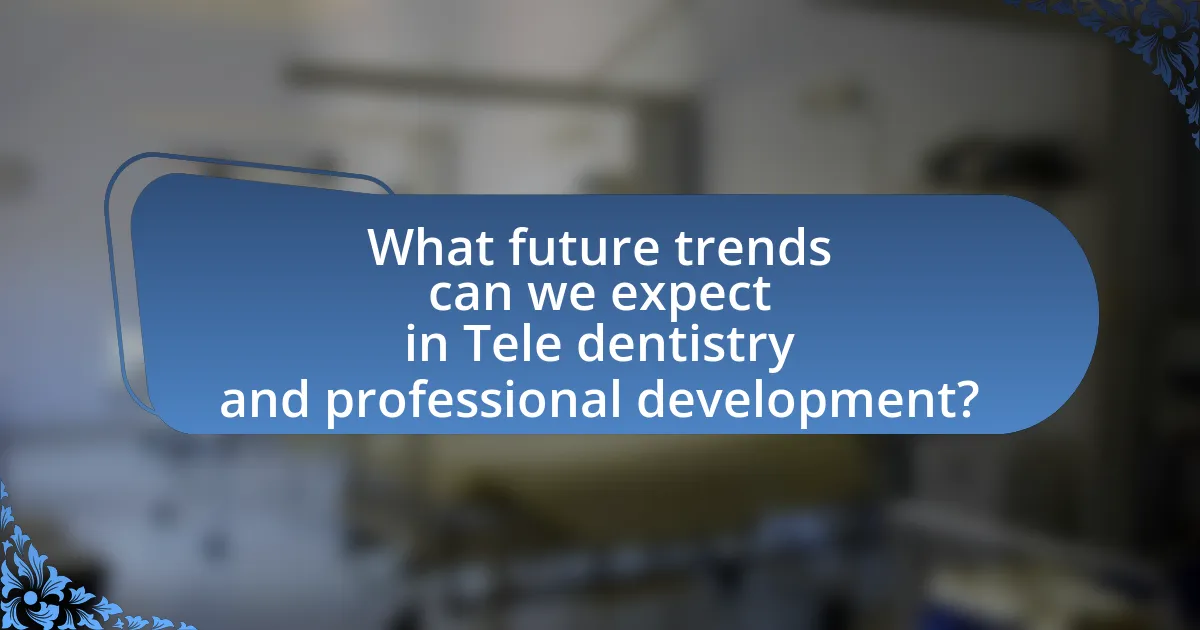
What future trends can we expect in Tele dentistry and professional development?
Future trends in tele dentistry and professional development include increased integration of artificial intelligence for diagnostics and treatment planning, enhanced remote patient monitoring technologies, and a growing emphasis on continuing education through online platforms. The adoption of AI tools is projected to improve diagnostic accuracy by up to 30%, as reported by the Journal of Dental Research. Additionally, advancements in telecommunication technologies will facilitate real-time consultations, allowing dental professionals to collaborate more effectively across distances. The rise of virtual reality and augmented reality in training programs will also provide immersive learning experiences, making professional development more accessible and engaging for dental practitioners.
How will emerging technologies shape the future of Tele dentistry?
Emerging technologies will significantly shape the future of Tele dentistry by enhancing diagnostic capabilities, improving patient engagement, and streamlining treatment processes. Technologies such as artificial intelligence (AI) and machine learning will enable more accurate assessments through advanced imaging analysis, allowing dentists to identify issues earlier and more precisely. For instance, AI algorithms can analyze dental X-rays with a reported accuracy of over 90%, surpassing traditional methods. Additionally, virtual reality (VR) and augmented reality (AR) will facilitate immersive patient education and treatment simulations, increasing patient understanding and compliance. Furthermore, the integration of telehealth platforms with electronic health records (EHR) will streamline communication between patients and providers, ensuring continuity of care and better management of dental health. These advancements collectively indicate a transformative shift in Tele dentistry, making it more efficient and accessible.
What role will artificial intelligence play in Tele dentistry advancements?
Artificial intelligence will significantly enhance tele dentistry advancements by improving diagnostic accuracy and streamlining patient management. AI algorithms can analyze dental images and patient data to identify conditions such as cavities or periodontal disease with high precision, reducing the likelihood of human error. For instance, a study published in the Journal of Dental Research found that AI systems achieved an accuracy rate of over 90% in detecting dental caries from radiographs, demonstrating their potential to support dental professionals in remote consultations. Additionally, AI can facilitate personalized treatment plans by analyzing patient history and preferences, thereby optimizing the tele dentistry experience for both practitioners and patients.
How might virtual reality impact training in Tele dentistry?
Virtual reality (VR) can significantly enhance training in Tele dentistry by providing immersive, hands-on experiences that simulate real-life scenarios. This technology allows dental professionals to practice procedures in a controlled environment, improving their skills without the risk of harming patients. Studies have shown that VR training can lead to better retention of information and increased confidence in performing complex tasks. For instance, a study published in the Journal of Dental Education found that dental students who trained with VR demonstrated higher proficiency in clinical skills compared to those who received traditional training methods. This evidence supports the notion that VR can effectively bridge the gap between theoretical knowledge and practical application in Tele dentistry training.
What best practices should professionals adopt for successful Tele dentistry?
Professionals should adopt clear communication, proper technology use, and patient engagement strategies for successful Tele dentistry. Clear communication ensures that patients understand procedures and expectations, which is crucial in a virtual setting. Utilizing reliable technology, including high-quality video conferencing tools and secure patient management systems, enhances the overall experience and maintains confidentiality. Engaging patients through educational resources and follow-up communications fosters trust and satisfaction, leading to better health outcomes. Studies indicate that effective communication and technology integration significantly improve patient adherence and satisfaction in telehealth settings.
How can practitioners ensure effective patient communication in Tele dentistry?
Practitioners can ensure effective patient communication in Tele dentistry by utilizing clear and concise language, actively listening to patient concerns, and employing visual aids during consultations. Clear language minimizes misunderstandings, while active listening fosters trust and rapport. Visual aids, such as diagrams or videos, enhance patient comprehension of dental procedures and treatment plans. Research indicates that effective communication in Tele dentistry can lead to improved patient satisfaction and adherence to treatment recommendations, as evidenced by a study published in the Journal of Telemedicine and Telecare, which found that patients reported higher satisfaction levels when practitioners used these communication strategies.
What strategies can enhance the integration of Tele dentistry into traditional practices?
To enhance the integration of Tele dentistry into traditional practices, dental professionals should adopt a multi-faceted approach that includes training, technology investment, and patient engagement strategies. Training programs focused on Tele dentistry can equip practitioners with the necessary skills to effectively use digital tools, as evidenced by studies showing that training increases confidence and proficiency in virtual consultations. Investing in reliable technology, such as high-quality video conferencing systems and secure patient management software, ensures seamless communication and data protection, which is crucial for maintaining patient trust and compliance with regulations. Additionally, actively engaging patients through educational resources about the benefits and processes of Tele dentistry can improve acceptance and utilization, as research indicates that informed patients are more likely to embrace new healthcare modalities.
